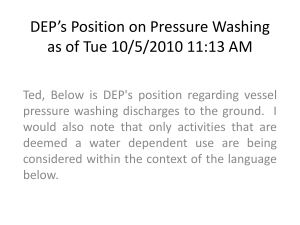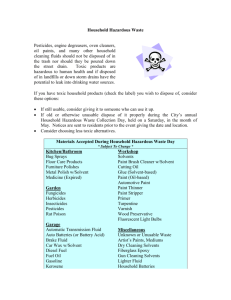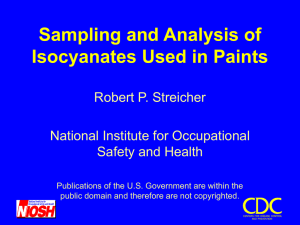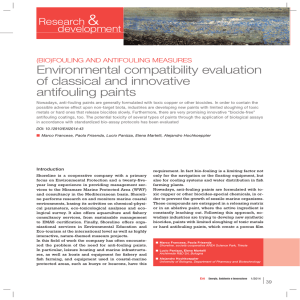Building Sheet 4 - Living Witness Project
advertisement
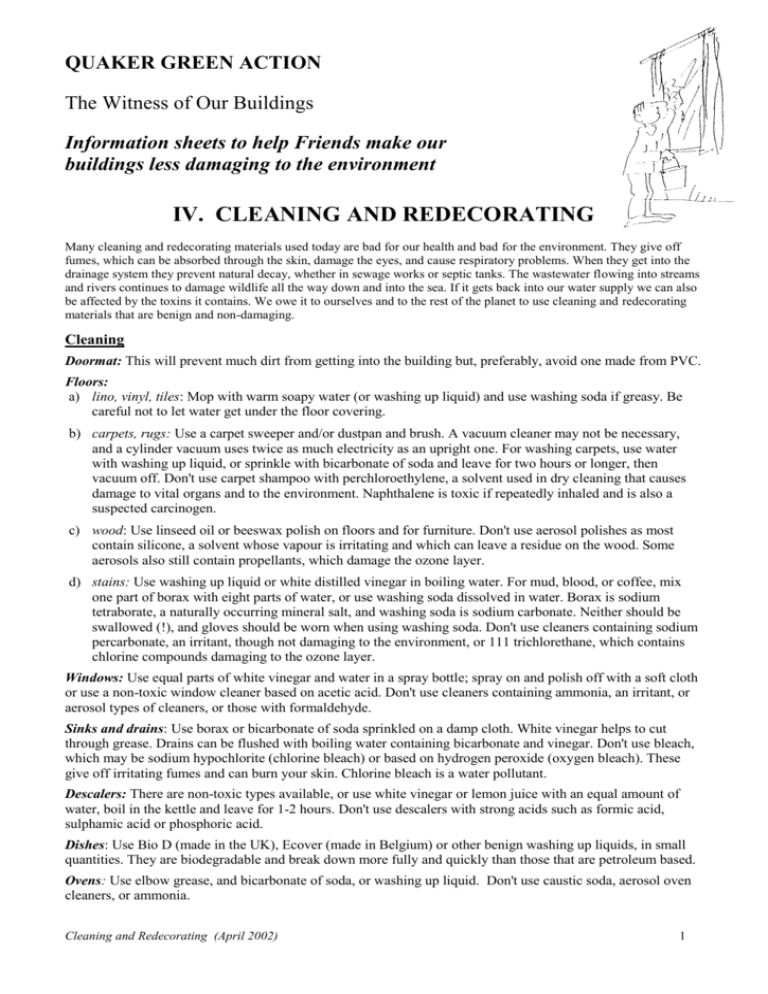
QUAKER GREEN ACTION The Witness of Our Buildings Information sheets to help Friends make our buildings less damaging to the environment IV. CLEANING AND REDECORATING Many cleaning and redecorating materials used today are bad for our health and bad for the environment. They give off fumes, which can be absorbed through the skin, damage the eyes, and cause respiratory problems. When they get into the drainage system they prevent natural decay, whether in sewage works or septic tanks. The wastewater flowing into streams and rivers continues to damage wildlife all the way down and into the sea. If it gets back into our water supply we can also be affected by the toxins it contains. We owe it to ourselves and to the rest of the planet to use cleaning and redecorating materials that are benign and non-damaging. Cleaning Doormat: This will prevent much dirt from getting into the building but, preferably, avoid one made from PVC. Floors: a) lino, vinyl, tiles: Mop with warm soapy water (or washing up liquid) and use washing soda if greasy. Be careful not to let water get under the floor covering. b) carpets, rugs: Use a carpet sweeper and/or dustpan and brush. A vacuum cleaner may not be necessary, and a cylinder vacuum uses twice as much electricity as an upright one. For washing carpets, use water with washing up liquid, or sprinkle with bicarbonate of soda and leave for two hours or longer, then vacuum off. Don't use carpet shampoo with perchloroethylene, a solvent used in dry cleaning that causes damage to vital organs and to the environment. Naphthalene is toxic if repeatedly inhaled and is also a suspected carcinogen. c) wood: Use linseed oil or beeswax polish on floors and for furniture. Don't use aerosol polishes as most contain silicone, a solvent whose vapour is irritating and which can leave a residue on the wood. Some aerosols also still contain propellants, which damage the ozone layer. d) stains: Use washing up liquid or white distilled vinegar in boiling water. For mud, blood, or coffee, mix one part of borax with eight parts of water, or use washing soda dissolved in water. Borax is sodium tetraborate, a naturally occurring mineral salt, and washing soda is sodium carbonate. Neither should be swallowed (!), and gloves should be worn when using washing soda. Don't use cleaners containing sodium percarbonate, an irritant, though not damaging to the environment, or 111 trichlorethane, which contains chlorine compounds damaging to the ozone layer. Windows: Use equal parts of white vinegar and water in a spray bottle; spray on and polish off with a soft cloth or use a non-toxic window cleaner based on acetic acid. Don't use cleaners containing ammonia, an irritant, or aerosol types of cleaners, or those with formaldehyde. Sinks and drains: Use borax or bicarbonate of soda sprinkled on a damp cloth. White vinegar helps to cut through grease. Drains can be flushed with boiling water containing bicarbonate and vinegar. Don't use bleach, which may be sodium hypochlorite (chlorine bleach) or based on hydrogen peroxide (oxygen bleach). These give off irritating fumes and can burn your skin. Chlorine bleach is a water pollutant. Descalers: There are non-toxic types available, or use white vinegar or lemon juice with an equal amount of water, boil in the kettle and leave for 1-2 hours. Don't use descalers with strong acids such as formic acid, sulphamic acid or phosphoric acid. Dishes: Use Bio D (made in the UK), Ecover (made in Belgium) or other benign washing up liquids, in small quantities. They are biodegradable and break down more fully and quickly than those that are petroleum based. Ovens: Use elbow grease, and bicarbonate of soda, or washing up liquid. Don't use caustic soda, aerosol oven cleaners, or ammonia. Cleaning and Redecorating (April 2002) 1 Toilets: Use white distilled vinegar to remove stains, and mild borax solution to disinfect, or sprinkle with bicarbonate of soda, leave overnight, and brush well in the morning. There are also eco-friendly toilet cleaners. Don't use bleach (see "Sinks and drains" above) and avoid air freshener blocks containing para-(or per) chlorobenzene, a serious water pollutant, or paradichlorobenzene which causes liver damage. Redecorating Internal Paint: Paints can cause environmental problems in their manufacture, use and disposal. The two basic types of paint are gloss paints (usually used for woodwork) and emulsion paints (usually used for walls) and both come in synthetic and plant-based forms. The manufacture of synthetic paints involves far more environmental negatives - higher energy use, depletion of non-renewable resources and production of toxic chemicals - than plant-based paints, with oil-based a bit worse that water -based. In water-based synthetic paints the oils have been replaced by complex formulations including emulsifiers, binders, de-foamers and setting additives. Both synthetic and plant-based gloss paints may be oil-based or water-based. In use, water-based paints are preferable for health and environmental reasons as they have lower VOC (volatile organic compound) ratings, so water-based synthetic paint is better for your health and local environment than oil-based plant paints, but they will have of course have caused more environmental damage in their manufacture than the plant paint. Best on all counts are water-based plant paints. Emulsion paints are available in 4 types: vinyl emulsion, acrylics, oil-based (disappearing from the market due to high VOC content) and plant-based paints. Vinyl emulsion is commonest and cheapest but acrylics have lower manufacturing impacts and higher durability. Plant-based emulsions usually use linseed oil and avoid problematic ingredients like fungicides and biocides. Titanium dioxide used especially in 'brilliant white' paints and added to most synthetic paints to provide opacity accounts for most of the energy used to produce paint and causes water pollution. It can cause respiratory problems and skin irritation and may be a carcinogen. If using synthetic paints avoid 'brilliant white' paints and dark colours. Disposal Left-over plant-based paints are biodegradable and can be composted when dried out. Conventional paints should be treated as chemical waste as they can cause serious water pollution.. Recommendations Plant-based paints (Auro, Livos and Nutshell) were recommended as the best environmental choice by the Ethical Consumer (Issue 58, May 1999). They are normally available only by mail order from specialist suppliers. The best environmental choice from the more mainstream options are ‘zero/minimal VOC’ paints from ECOS and B&Q, and Casa acrylics from Homebase. Paint stripper, thinners and cleaning fluids: There are plant-based versions available from Auro, Livos and Nutshell. Don't use a stripper containing dichloromethane or sodium hydroxide (caustic soda) as these are very toxic. Wall coverings: There are a variety of these, including paper, cork, and hessian or jute cloth. Vinyl wall paper is waterproof and will trap moisture, and also releases fumes which may be irritating. FSC certified wall papers (made from sustainably produced wood) are now readily available. External The best gloss paint for exterior woodwork from an environmental point of view is the water-based plant-based paint which is now available from Auro, It should last 3 to 5 years, if properly applied, according to AURO. Plant-based wood stains and other wood treatments are available. Manufacturers Manufacturers ethical and environmental records are described in more detail in The Ethical Consumer, Issue 58, May 1999 for paints, Issue 54, Aug 1998 for household cleaners and Issue 63, March 2000 for washing-up liquids. Regarding cleaning products Bio-D (available from Natural Collection and SUMA, for example) came out best, then Clearspring, Caurnie and Little Green Shop. Of brands more widely available Ecover came out by far the best. Cleaning and Redecorating (April 2002) 2 References Kruger, Anna: H is for EcoHome, Gaia Books Ltd., 1991 Vallely, Bernadette, et al: Green Living, 1991 Brown, Lynda: organic living, simple solutions for a better life, A Dorling Kindersley Book, 2000 Ethical Consumer: 0161 226 2929; www.ethicalconsumer.org Suppliers Recommended for low/minimal VOC synthetic paints: B&Q, Sainsbury's Homebase (Casa paints) For plant paints by mail order: Centre for Alternative Technology (CAT): Machynlleth, Powys SA20 9AZ; 01654 702400; www.cat.org.uk Green Building Store: 01484 854898; www.greenbuildingstore.co.uk Auro Organic Paint Supplies: Unit 1, Goldstones Farm, Ashdon, Saffron Walden, Essex CB10 2LZ; 01799 584888; www.auroorganic.co.uk Casa Paint Company: PO Box 77, Thame, Oxfordshire OX9 3FZ; 01296 770139; www.casa.co.uk Lakeland Paints (ECOS): Unit 19, Lake District Business Park, Kendal, Cumbria LA9 6NH; 01539 732 866 Livos Natural Paints: Unit D7, Haws Craft centre, Jackfield, Ironbridge, Shropshire TF8 7LS; 01952 883288; www.livos.com Nutshell Natural Supplies: Hamlyn House, Mardle Way, Buckfastleigh, Devon TQ11 0NR; 01364 643888 For plant paints and green cleaning materials by mail order: The Green Shop: Bisley, Stroud, Glos GL6 7BX; 01452 770629; www.greenshop.co.uk For green cleaning materials by mail order: Natural Collection: 0871 331 3333; www.naturalcollection.com Ecozone: 020 8777 3121; www.ecozone.co.uk Ecover green cleaning materials are available in many health food stores. Another good source, if you have a local wholefood buying group ordering goods in bulk, are the co-operative wholefood suppliers such as : SUMA: Lacy Way, Lowfields Business Park, Elland HX5 9DB; 0845 458 2290; www.suma.co.uk Cleaning and Redecorating (April 2002) 3

